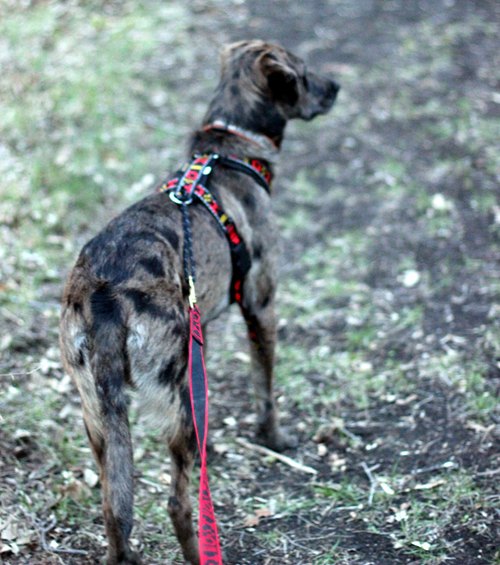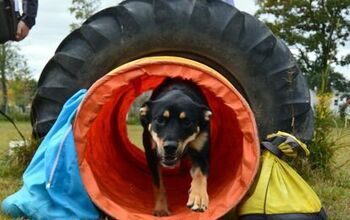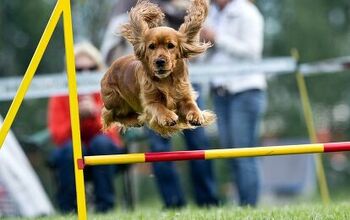Dog-Powered Running: Get Fit With Canicross

I run down the trail with my dog, and I pass another runner who mumbles “Cheater” under his breath. While he is so obviously jealous that my dog and I are such an awesomely fast team, it’s also clear that he has never heard of the sport of Canicross. And FYI, buddy – I’m not cheating because it’s a lot of work on my part!
Canicross is canine plus cross country running. All you need is a trail, a runner and a dog. The catch? The dog and human are attached to each other (one reason why this sport is so cool). You and your dog are a team as you work together to take on the trails.
Related: Exhilarating Workouts For You And Your Dog
If your dog likes to run and is reasonably physically fit, canicross can be an excellent work out! Smaller dogs, such as Beagles or Cocker Spaniels, may have the energy of a sled dog but not the strength. Canicross gives them street cred of an extreme sport to brag about at the dog park, without the added weight of hauling a sled. Big or small, canicross is a perfect fit for pretty much any breed.
Another great perk about this sport: canicrossers (that’s a fancy name for you and your dog) need little gear. Obviously, the human needs a good pair of shoes to handle the rigors of trail running. You’ll also need a hip belt, also called a trekking belt or a skijoring belt. There are a few options for hip belts on the market. My personal preference is a belt that doesn’t skimp on the width. I don’t want the belt digging into my back as I run – what a pain in the back! A wide belt eases the pressure on your back and is an overall more comfortable fit.
The runner and the dog are attached via a bungee line. You’ll need a line that’s about six to nine feet. The length really depends on how fast you plan to run, where you plan to run, and what you and your dog are comfortable with. If you have an excitable dog and are running on busy shared trails, go for a shorter line. If you’re running a fast dog on trails with some twists and turns, a longer line will give you the flexibility you need.
Related: Wheely Good Time: Bikejoring and Scootering
Harness Fit
Proper harness fit is essential to the health and performance of your dog. While those involved in canicross have their personal favorite, the right harness for your dog ultimately is decided by which one fits your dog best.
What you should be looking for is a properly padded, short harness. Some canicrossers I know run their dogs in traditional sled dog harnesses, also known as an X-back harness, but these are meant for sled dogs. When dogs are hauling a weight with a team of other dogs, the attachment point for the sled comes straight out from their back on the X-back harness. Most canicrossers are taller than their dog, and this means the line goes up at an angle from the dogs back. That means if you’re using an X-back harness, it’s not only uncomfortable for the dog to run in, but can also create problems during the run.
Before you head out on the trails, check that the harness fists properly. If you’re ordering online, the retailer will ask for a series of measurements to help ensure the best fit. The harness should sit just above the dog’s shoulder blades. Too tight a harness and your dog will choke. Too lose and it will interfere with your dog’s gait. Proper fit is essential for both enjoyment and health, so follow the manufacturer’s instructions to ensure the best size! Even better, have the harness fit in-person by a knowledgeable canicrosser (search your area for canicrossing organizations or sporting goods stores on Google).
Hydrate
While running the trail, your dog is going to need water… and lots of it! The trick is to get your dog to drink enough water before hand to be properly hydrated for his run. If you are feeding a kibble-based diet, soak the kibble in water the night before a run. This will help get some added H2O into your dog.
You may want to consider baiting your dog’s water with something tasty. A drop of vanilla ice cream, some low sodium beef broth, or a little bit of beef fat melted into water will entice your dog to drink enough water to stay hydrated for the run. Make sure that you water your dog at least an hour before you hit the trail (to prevent bloat).
Foot Check
Get into the habit of inspecting your dog’s paw pads before and after every run. You’re looking for any small cracks or fissures in the paw pads. Also be on the lookout for paw pads that are smooth to the touch, sometimes seen with small beads of moisture making an appearance. This warning sign tells you that you have run your dog too far and have worn down their paw pads. Take a few days off, so your dog’s feet can recover. Running on hard surfaces can really aggravate your dog’s paw pads, but an ounce of prevention is worth a pound of cure. Try a paw balm, like Musher’s Secret, that will condition your dog’s paw pads properly.
Pack Power
You and your dog can hit the trails alone, but if you are looking for company, know that there are canicross clubs and events all over the world. A search on Google or Facebook will bring up plenty clubs in your area that promote the sport. Most clubs host races as well as training days, so you can brush up your skills or set a goal to compete.
Have I converted you into a fan – or at least an intrigued onlooker – of canicross? Do you need any more encouragement? Feel free to leave any questions about canicross in the comment section below and I’ll be sure to answer them!

Kevin Roberts lives for adventure. Together with his pack of rescue dogs and his husband, he spends as much time outdoors as possible. Kevin lives by the motto: "Get outside and play with your dogs!
More by Kevin Roberts


























